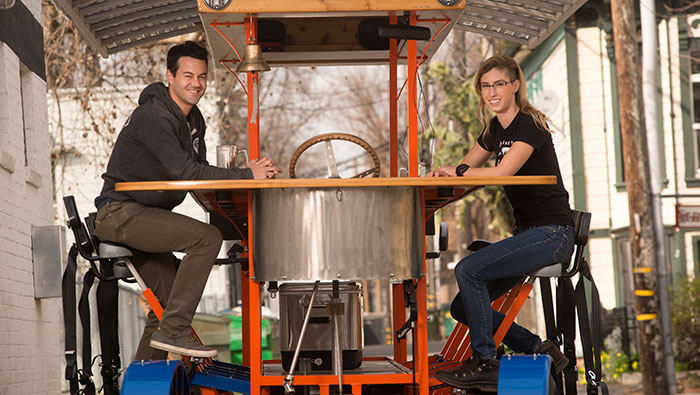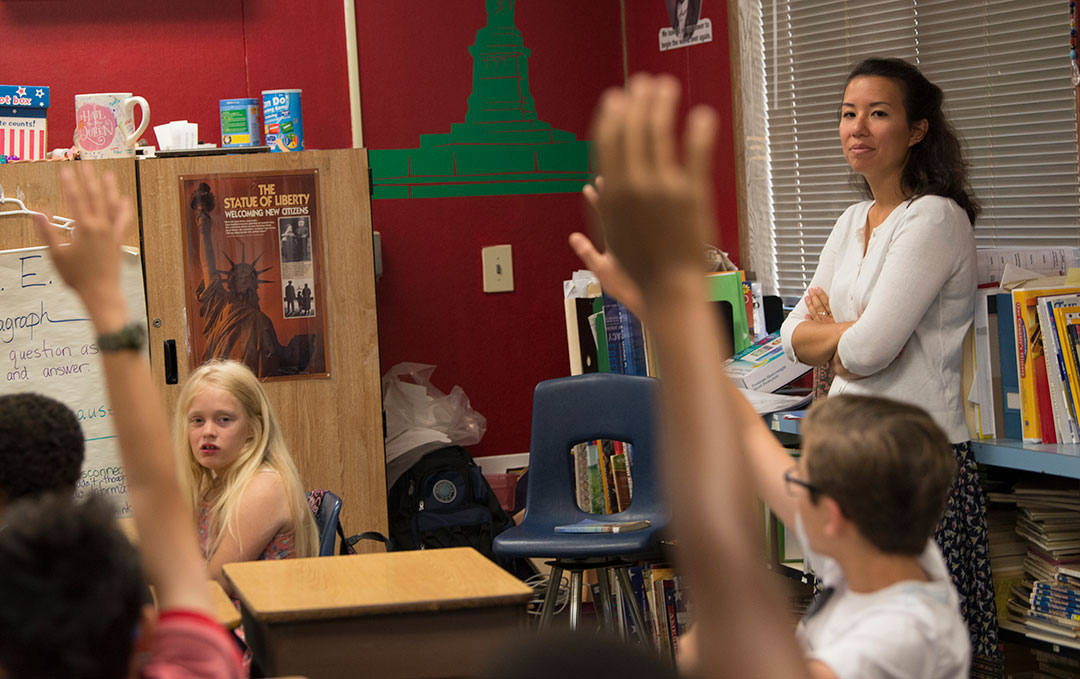
While the international COVID-19 pandemic has driven many inside their homes, millions of people continue to do essential work. Small businesses have utilized creative ways to continue to offer their services to the community, newsrooms have moved into living rooms, and students and teachers alike have adapted to remote learning. UC Davis Magazine spoke with three alumni who are reflecting on their experiences as essential workers right now.
Sarah Ferren-Cirino ’09 and her husband, Chris ’07, have owned the Sacramento Brew Bike and Boat since 2014, offering private pub crawls around town. What started as one bike grew to a six-bike and two-boat operation, with a taproom space in Midtown.
Due to the impacts of the pandemic, they have had to stop the pub crawls but are still providing beer and wine to the community.
Ferren-Cirino partnered with her sister Stevie Stacionis and her husband’s beer and wine bottle shop Bay Grape, based in Oakland. Sac Brew Bike began selling Bay Grape’s inventory to their Sacramento customers, offering pre-order cases of beer and wine.
The key is being flexible, Ferren-Cirino said. She now spends her days staying updated on Centers for Disease Control and Prevention guidelines and state regulations, as well as advertising the business on social media.
“How do you create a business plan or policy in terms of making a comfortable work environment, for both your customers and your employees during this challenging time?” she said. “There are so many question marks, a lot of which are driven by social norms, but social norms have been blown apart at this point. It’s a challenge.”
Ferren-Cirino said she hopes to utilize their six bikes for socially distanced rides in the future. And although business looks different today, the goal is the same.
“Our business model is based on a sense of community and a gathering place where people feel safe. It’s a way for people to celebrate. We’re hoping we can go back to that, but we are doing these offsite sales right now to hopefully bring some brightness into people’s lives,” said Ferren-Cirino. “We’re being creative while safety conscious.”

Creative strategies have become a common theme. Sawsan Morrar ’06, a reporter at the Sacramento Bee, continues to report the news while taking care to remain safe. “Someone actually made face masks that say ‘Sacramento Bee’ on them, so we are easily identifiable as reporters,” she said.
Morrar began working from home in mid-March. “I have a makeshift office,” Morrar explained, “and all of the press conferences are virtual now. However, there are still times that I’ll go out in person, to take interviews and work with a photographer, to find sources, to speak with people.”
Meeting with people in the field is essential to the work of a journalist. “While a lot of reporting and research can be done through email or online, there is a really important element of meeting people in person, to gain the trust of our sources.”
To do so safely, Morrar wears a face mask and even gloves. When she returns home, she changes out of her clothing immediately. “On one occasion, I completely washed up and everything, to make sure I’m re-entering my home clean.”
But to Morrar, the added safety measures are worthwhile.
“Meeting people face to face adds so much to the story,” she said. “It’s important to do our job and inform the public what’s happening around them and hold officials accountable. That way people can make informed decisions during this pandemic.”
She is also keenly aware that she is simultaneously reporting during this time of crisis and living through it. “Everything I’ve been reporting is directly affecting me,” she said. “There are times when I haven’t been able to sit down and let the information sink in. It’s not denial, but I’m working at a fast pace, trying to get the news out there.”
To remain grounded, Morrar goes on long walks on trails around her home and enjoys bike rides. “My colleagues are so resilient, and we’ve been able to adapt to such big changes,” she said. “I think the concept of a ‘new normal’ frightens people, but the last two months have shown me we’re going to be OK. We are all much more resilient than we realize.”

Even some of the youngest people impacted by the pandemic are proving their resilience every day. “My 10- and 11-year-old students are attending Zoom office hours. They are advocating for themselves, their grades, and their learning,” said Lauren Yayesaki, M.A. ’18, a history teacher at David Lubin Elementary School in Sacramento.
Yayesaki, with her teaching partner, previously taught 66 students every day. Now Yayesaki instructs her class of fourth and fifth graders through Zoom and Google Classroom.
The transition has been challenging, she said. “In a classroom setting, it’s easy for me to walk over and see that someone is not engaged and I can modify accordingly. Luckily, I can still anticipate my student’s needs because I’ve had them for two trimesters now, but the disconnect is there. They can’t just come over and ask for help.”
Despite the physical distance, Yayesaki has kept her students engaged through thoughtful discussions and creative approaches. “On Monday, we had a conversation about George Floyd,” she said. “We’ve learned about other forms of protest in American history, like the Civil Rights Movement and the Suffragette Movement, I really wanted to compare this to other kinds of protests in history and what’s going on today. Sometimes it’s hard to connect things, but if you can connect events in the past to a form of protest happening now it’s easier for students to understand.”
Yayesaki has also tried to recreate the social aspect of the classroom setting. “We have Zoom parties every Friday night. We play games,” she said. “It’s a great time to talk to them, socialize and hear their thoughts on how Google Classroom has been working. It’s really helpful.”
The shift to remote learning has increased the time Yayesaki spends working, a new commonality among teachers. She’s had to quickly learn technologies and put together her materials in different ways.
Yayesaki said she relies on her network of teacher friends across the U.S. to share ideas and discuss remote learning struggles. Connecting and debriefing with them has offered support and guidance.
“It’s very important to me to make sure my students feel like their voices are heard,” she said. “I want them to know that just because I don’t see you every day, it doesn’t mean I don’t care about you.”